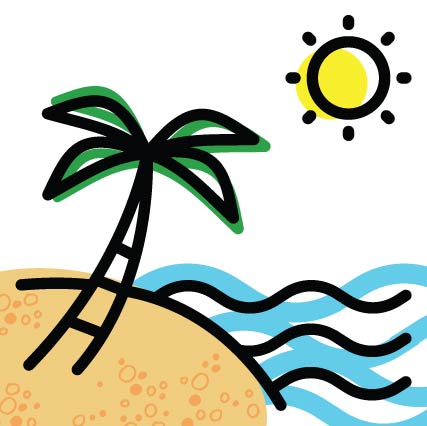 The sun is out, the weather is hot, and the beaches are reopening. It’s officially Summer.
The sun is out, the weather is hot, and the beaches are reopening. It’s officially Summer.
In our previous blog article, How to Stay Safe This Summer & Still Enjoy the Sun, we provided a few safety recommendations and rated the risk of 14 common summer activities. However, it's been a few weeks and even though the spread of COVID-19 is still prevalent, many businesses, restaurants, parks, and beaches have begun to gradually reopen. And even though things are seemingly returning to “normal," there is now an endless pool of information out there on what you should or shouldn't do this summer to avoid contracting or spreading the Coronavirus.
To help you feel less overwhelmed with the amount of information out there and to offer assurance as to what summertime activities you and your family can safely participate in, we decided to dig through it all, break down a few key questions, pull in the experts, and address the following topics in depth.
Do you need to wear a face covering when outdoors?
Regulations around wearing face coverings will vary from place to place. Before you go anywhere this summer, check ahead to see if face masks are required.
If you’d like to go for a walk or run outside, the general recommendation is to keep at least six feet apart and where a face covering. In this Everyday Health article, Dr. Humberto Choi, MD, states that “...if someone is walking or running in front of you, it’s probably a good idea to stay more than six feet behind them. If that person was infected with COVID-19 and they sneezed or coughed it could create a cloud of aerosol in the air; if you are right behind that person, you might walk or run through that.”
Furthermore, if you’re out riding a bike, you don’t necessarily need a face covering but should consider wearing one if there are other riders or lots of people around.
Are backyard barbeques, picnics in the park, or outdoor parties okay?
Before attending or hosting any outdoor party, barbeque, or picnic, it’s important to research local rules around gatherings, always plan ahead, and consider the rate of COVID-19 transmission in your community. Gatherings with a few people are probably fine as long as everyone follows social distancing rules. However, any large gatherings increase the risk of infection and everyone should not only social distance themselves, but wear face masks as well.
When it comes to sharing food, Dr. Choi recommends that “If you aren’t from the same household, it’s a good idea to bring your own food, drink, supplies, and utensils to avoid transmitting the virus through surfaces.”
For basic suggestions on how to have a safe picnic outdoors, read Lehigh Valley Health Network’s Do’s and Don’ts: Summer Picnics, Coronavirus-Style.
Are beaches, swimming pools, and hot tubs safe?
Currently, there is no evidence that the virus that causes COVID-19 spreads through water in pools, hot tubs, spas, or water parks according to CDC experts.
But while you may be safe in the water, there is still an ongoing community spread of the virus among the dense crowds attracted to and present at these public places. And when in the water, it can be hard to wear a mask or difficult remembering to keep 6-feet away from everyone.
Bottom line, as beaches continue to reopen and if public pools open at all, you can still enjoy the water and your children can still splash around, but you must follow proper social distancing both in and out of the water and be fully aware of your surroundings.
For other concerns and safety questions specific to hot tubs, lakes, water sports, and beaches, UC Health offers extensive valuable information.
Should you use public restrooms?
If you gotta go, you gotta go. Whether you’re at a park, at the beach, or on the road this summer, one of the main concerns to address is whether or not public restrooms are safe to use.
Most opened public restrooms are required to follow certain CDC guidelines, but according to infectious disease experts, they are still perfect for the transmission of COVID-19. They are small, enclosed spaces that are poorly ventilated with plenty of high-touch surfaces including sinks, door handles, toilets, and countertops. With this said, if you absolutely have to use a public restroom, there are a few key steps you can take to limit your exposure to the active virus.
Wear a mask, use toilet seat covers, use paper to touch any handles, wash your hands thoroughly after you leave, and bring your own hand sanitizer with at least 60% alcohol. If you feel more comfortable, you can also wear plastic gloves and bring your own toilet paper.
What guidelines can I follow when traveling?
Since the chances of getting and spreading COVID-19 are increased when traveling, staying home is still the best way to protect yourself, your family, and others from getting sick or spreading the virus.
Before traveling, plan ahead, exercise caution, and find out the rate of COVID-19 transmission both in your own community and place of destination. Determine if those you are traveling with or traveling to are more likely to contract the virus due to older age or other underlying medical conditions. Keep in mind that while traveling, you have the potential to get infected, and if you have COVID-19 but no symptoms, you could still spread it to others.
Whether you’re taking a road trip or traveling out of state, the CDC offers a variety of travel considerations and toolkits for your use.
We hope these simple recommendations will help you feel safe while you enjoy some summertime fun.








Add new comment